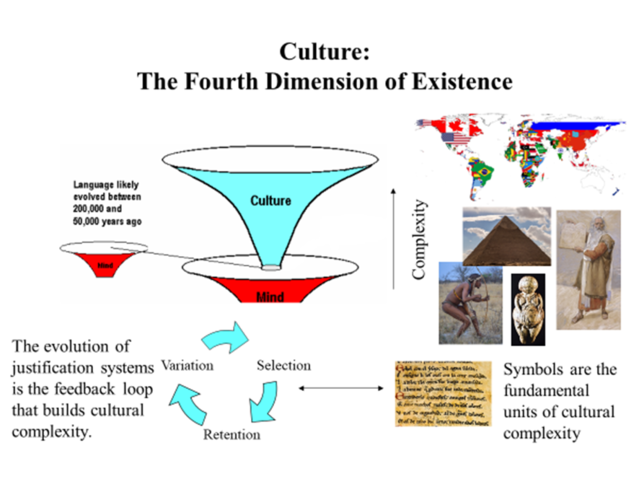Philosophy
5 Phases in the Evolution of Human Cultural Sensibilities
Tracing the evolution of human consciousness and culture in five phases.
Posted October 4, 2019
This blog was co-authored by Lene Rachel Andersen and Joe Michalski.
In her book, Metamodernity: Meaning and Hope in a Complex World, Lene Rachel Andersen traces the evolution of culture and human knowledge and self-consciousness across five phases of sensibilities (i.e., indigenous, pre-modern, modern, postmodern and metamodern). Her conception of these “cultural codes” and how they have evolved align closely with how the ToK System conceptualizes the evolution of Culture, defined as large-scale systems of justification. This blog combines the two perspectives to describe the evolution of human cultural sensibilities in five stages.

Stage I: Premodern, Indigenous Social-Tribal Sensibility (50,000+ years ago)
By 50,000 years ago, a remarkable transition in human culture and consciousness had taken place. Following Donald, the archeological evidence suggests that a transformation occurred such that human communication had gone from a fractured “mimetic system” into an open language system with syntactical rules that enabled the emergence of abstract reasoning, symbolic thought, and the ability to pose questions. The central insight of JUST is that the capacity to ask questions created the adaptive problem of social justification and the emergence of feedback loops. We can call such systems the first systems of “social epistemology.” This is what Donald refers to as “mythic” knowledge, or the intersubjective linguistically mediated socio-cultural construction of knowledge.
When exactly the transition into this mode of being and perceiving happened is unclear. However, many things are shared across human indigenous cultures that separate us from the other great apes such as language, music, animism, shamanism, art, and complex tools. During this period, all culture was oral and thus stored knowledge in other symbols, such as rituals, body ornaments, song, and dance. In addition, indigenous cultures are mainly hunter-gatherers, do not amass more artefacts and tools than can be carried around, and do not differ much in material wealth. The day-to-day groups are no bigger than a few dozen people, power differences are small, and everybody can talk to everybody, though wise elders and shamans / medicine (wo)men have higher status than others. Hunter-gatherers tend to nature as animated by spirits, with humans thought of as an integral part of nature.
An Emerging Transition: The Seeds of Formal Thought (10,000+ years ago)
Approximately 10 to 12,000 years ago a massive shift in human behavior emerged. Humans in the Middle-East (and gradually elsewhere) transitioned from a hunter-gatherer and sporadic horticultural culture to an agrarian way of life. This coincided with a major climate change 11,000 years ago, which quite abruptly ended the last ice age as Earth entered the Holocene.
In God: A Human History, Aslan argues that it may well have been humanity’s search for meaning and the idea of God [or gods] that drove the construction of temples and thereby the emergence of cities. One such example is the site at Göbekli Tepe. Such temples required the alignment of investment practices, technology, and meaning making. Whatever the ultimate cause of agriculture, the net result was that people formed permanent settlements that and created new social arrangements. Although the new lifestyle presented new challenges, it set the stage for human organization on a much larger scale than ever before.
Humans began accumulating resources and wealth, while engaging in systematic trade practices. The need to record such practices set the stage for the earliest forms of writing. However, once writing emerged, it added to the technological mix, and spurred another massive transition. Writing is external memory. Its importance can be seen when we consider that the term “history” really references human written history.
Stage II: The Axial Age and the Emergence of Pre-Modern, Formal Sensibilities (2500+)
The philosopher Karl Jaspers coined the term Axial Age to describe the climate belt from Italy across Asia to China from about the 8th to the 3rd century BCE. He argued that it was a "pivotal age" because new ways of thinking emerged in Persia, India, China and the Greco-Roman world in religion and philosophy. In the language of the ToK, there emerged “formal” systems of justification, which likely related to the size of the civilizations and the development of writing and elite literacy. Mathematics also emerged which played a crucial role in the transition from a purely social epistemology to a more formal-analytic epistemology. The teachings of Socrates, Plato, and Aristotle played a central role in the development of Western philosophy. Via analytic questioning, Socrates plants the idea that social epistemology is (potentially) analytically vacuous. Plato and Aristotle take up the mantle to develop formal-analytical philosophies that attempt withstand Socratic-like philosophical criticism. In the Western lineage, this is the beginning of formal, refined academic knowledge as separate from common social epistemology. From 400 AD onward, Europe saw the blend of this way of thinking with the Judeo-Christian tradition.
Stage III: The Scientific Revolution and the Modern Enlightenment Sensibility (500+ years)
By the 16th century, European intellectuals had divided the natural and supernatural domains and determined the former could be investigated systematically. This set the stage for the invention of the empirical method. Although Aristotle and others encouraged systematic investigation, modern science nevertheless gave rise to a new form of justification. This was not least due to the technological development during the Renaissance that allowed new kinds of measurements.
The Enlightenment was marked by the idea that reason and liberty could produce ultimate truth and generate human progress. Via the work of scientists like Newton, Maxwell, Darwin and Einstein, the power of reason shined. In addition, powerful philosophical works from Hume, Kant and Hegel saw a golden age of synthetic visions and progress, while liberal democracy spread throughout the West.
100+ years ago: The Foundations of Modernism Start to Crack
Despite its remarkable success and the explosion of human technological development in the industrial age, the modernist sensibility did not deliver a fully adequate picture of humanity and our place in the cosmos. Nietzsche’s critique stood as a powerful force that demonstrated potential cracks in the modernist tradition. By the beginning of the 20th Century, a clear break is forming between the pure analytic philosophy traditions and the synthetic traditions. The tragic horrors of WWII and other authoritarian regimes, arguably predicted by Nietzsche, offered a powerful challenge to the idea that humanity was on a linear path to progress ensured by a pristine rational vision. As the horror of brutal oppression via racist categories becomes seared into human consciousness, movements for civil rights are sparked across the globe.
Stage IV: A Postmodern Sensibility (50+ years ago)
Massive social movements emerge in the 1960s as people demand changes in the existing power structures. Civil rights, feminism, and protests of the Vietnam War rock North American and European sensibilities. A transformation also occurs in the academic focus of philosophers, one that begins to challenge the capacity for a singular rational vision. The later Wittgenstein embraces the fact that language systems operate as tools and thus the construction of knowledge of everyday life is inevitably contextual. He notes that we are “language game” players. The sociologists Berger and Luckmann chart the social construction of reality, while Irving Goffman illustrates the power of micro-sociology.
The argument that there is an inevitable fusion of truth with social power is consolidated by postmodern/post-structuralists like Derrida, Feyerabend, and Foucault. In 1979, Lyotard captures the essence of the postmodern sensibility as being the absence of the grand narrative. The postmodern sensibility offers a critical, skeptical critique of modernist knowledge and concludes that it is always contextual. Although key elements of this critique carry validity, if taken to its logical extreme, it results in unworkable conclusions regarding the impossibility of authentic knowledge. The fracturing of knowledge plays a central role in the modern meaning crisis.
Stage V?: Seeds of a Metamodern, Meta-Cultural Consciousness (10+ Years ago)
Since 2010, a “metamodern” movement has gained steam. It seeks to transcend the fragmented pluralism and explore an integrated pluralism that allows for positive, constructive work on a post postmodern grand meta-narrative. This emerging movement consists of blogs, conferences, festivals, and political manifestos. With its unifying framework and emphasis on a consilient meta-language between objective science, subjective phenomenology, and a universalist, intersubjective moral vision toward the ultimate good, the ToK System framework is clearly a metamodern theory for the 21st Century (see here for others).
Lene Rachel Andersen’s Metamodernity offers a clear articulation of the metamodern sensibility. She characterizes metamodernity as an alternative to both modernity and postmodernism, a cultural code that presents itself as an opportunity if we work deliberately towards it. Such a sensibility includes the indigenous, premodern, modern, and postmodern codes that preceded it and thus it provides a kind of “meta-cultural consciousness” that allows for a moral tapestry that weaves together intimacy, spirituality, practical religion, science and self-exploration at the same time. In short, it is about developing a new system of understanding that will function as integrated pluralistic justification system that scales from the individual to the globe.




